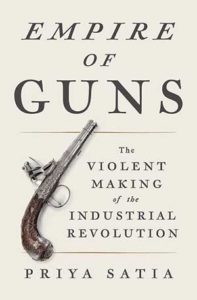Empire of Guns: The Violent Making of the Industrial Revolution
Reviewed by Larry Ingle
August 1, 2019
By Priya Satia. Penguin Press, 2018. 544 pages. $35/hardcover; $22/paperback (available in October); $15.99/eBook.
This big book (approximately 420 pages of text) has a large theme. Its author chose to place a practically unknown English Quaker, gun manufacturer Samuel Galton Jr., and his reaction to his disownment by his meeting in Birmingham, England, at the center of its thesis. What Stanford historian Satia argues is that the Industrial Revolution of the seventeenth and eighteenth centuries, and by extension the British Empire—the one on which the sun never set—was fueled and made possible by guns made in Birmingham. Galton’s family produced guns during almost all of this time; they were probably the largest gun maker, a center of the industry.
Satia places Galton in her introduction and refers to him periodically throughout her book, but waits until she is nearly two-thirds finished, in chapter 8, to detail his written contribution. In chapters 9 and 10, she exhaustively explores the development of guns: their manufacture, usage, and attempts to control them down to the present. Satia has expertly explored the primary sources regarding Galton, but knows little about the Society of Friends, calling it a “church”; never using “meeting”; and stripping it of its religious content, making it appear that the only reason it existed was to promote peace. She describes English Friend Edward Hicks, editor of the obscure monthly Quakeriana (1894–96), as “an American,” conflating him with Edward Hicks the painter, dead since 1849.
Readers of Friends Journal will probably find Satia’s wordy scholarship on guns rather tiresome, but they will be fascinated with her account of Galton and his significance. In 1795 Galton’s Birmingham Meeting moved to disown him for making and selling guns by dispatching visitors to admonish him. Unmoved, Galton refused to desist and was subsequently disowned.
He then wrote a lengthy reply to the meeting, which he published as a public defense. He averred that the meeting had not moved against any member of three generations of his family in the previous 90 years and queried why it had taken so long for them to become aware of the sin of gun making and selling. He cited Friends as worthy as Isaac Penington, who had opposed the 1661 testimony against carnal weapons. But his most telling argument suggested that every Friend—indeed, every Briton—was as guilty as he: don’t we all pay taxes; don’t we all put our money with banks closely tied to gun makers; don’t we all buy sugar and cotton produced with slave labor? (Friend Galton was an ardent supporter of boycotting the purchase of such commodities.) Aren’t we, in short, part of the whole? Can any of us rightfully claim to be free of contamination by society’s collective evil?
Heightening the irony, Satia writes that Birmingham Meeting’s rejection of Galton’s argument suggested its members had fallen victim to a false consciousness—one continuing today—allowing them to avoid “the truth that modern life is founded, intrinsically, on militarism and that industrial life has historically depended on it.” It has long been obvious that Quakerism, emphasizing individual responsibility, gave a religious push to the capitalist urge. That it also played a pivotal role in the Industrial Revolution and the consequent empire may well occasion a rewriting of history texts.
And for Friends this irony was compounded by the fact that less than a decade after his disownment in 1796, the meeting accepted his donation to enlarge its burial ground. This decision not only violated the terms of his disownment but also underscored that gun-gained wealth had trumped his sin.




Comments on Friendsjournal.org may be used in the Forum of the print magazine and may be edited for length and clarity.